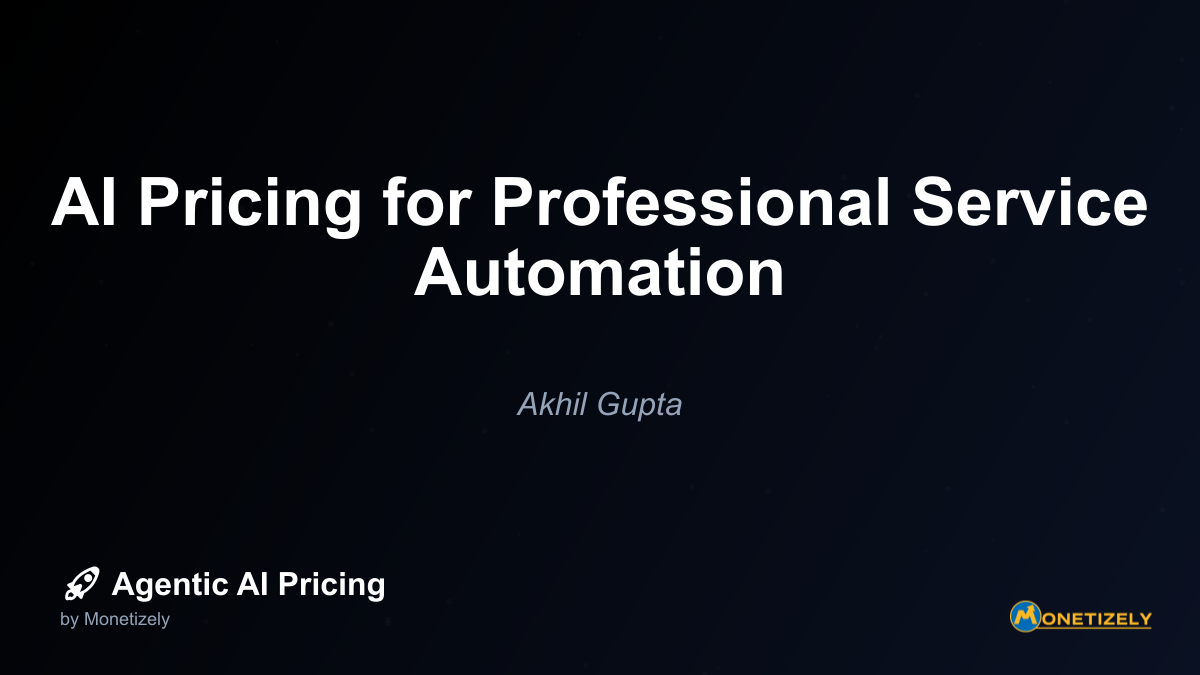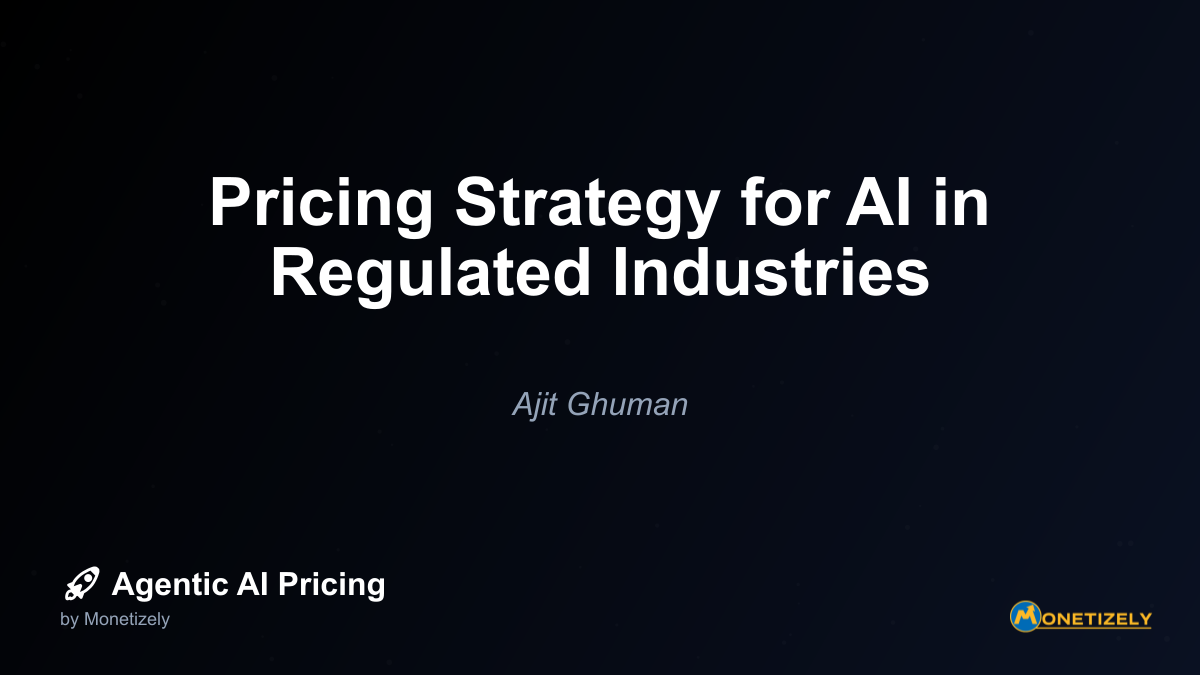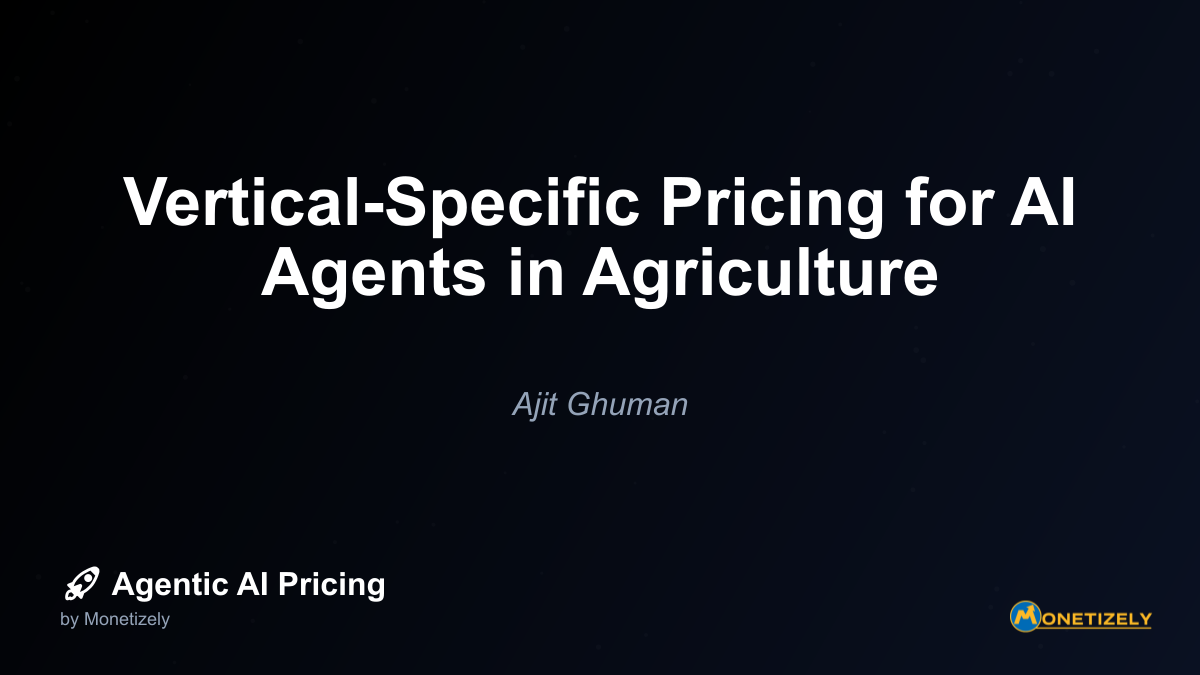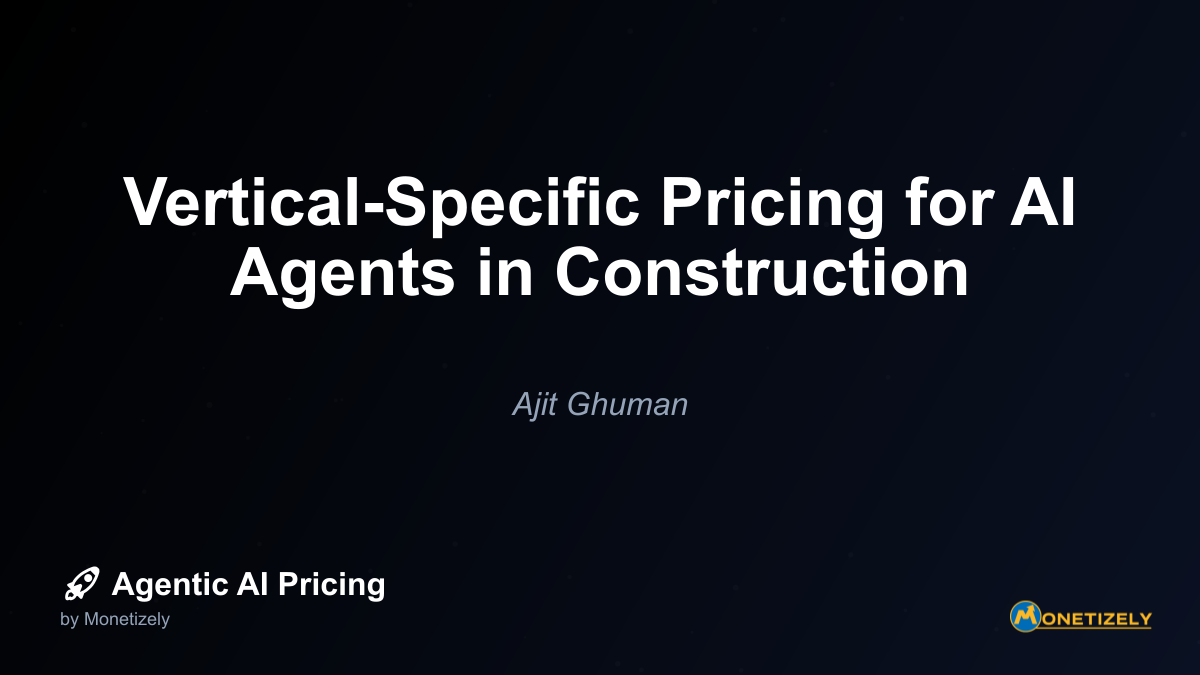· Ajit Ghuman · Industry-Specific · 13 min read
Vertical-Specific Pricing for AI Agents in Energy and Utilities
AI and SaaS Pricing Masterclass
Learn the art of strategic pricing directly from industry experts. Our comprehensive course provides frameworks and methodologies for optimizing your pricing strategy in the evolving AI landscape. Earn a professional certification that can be imported directly to your LinkedIn profile.
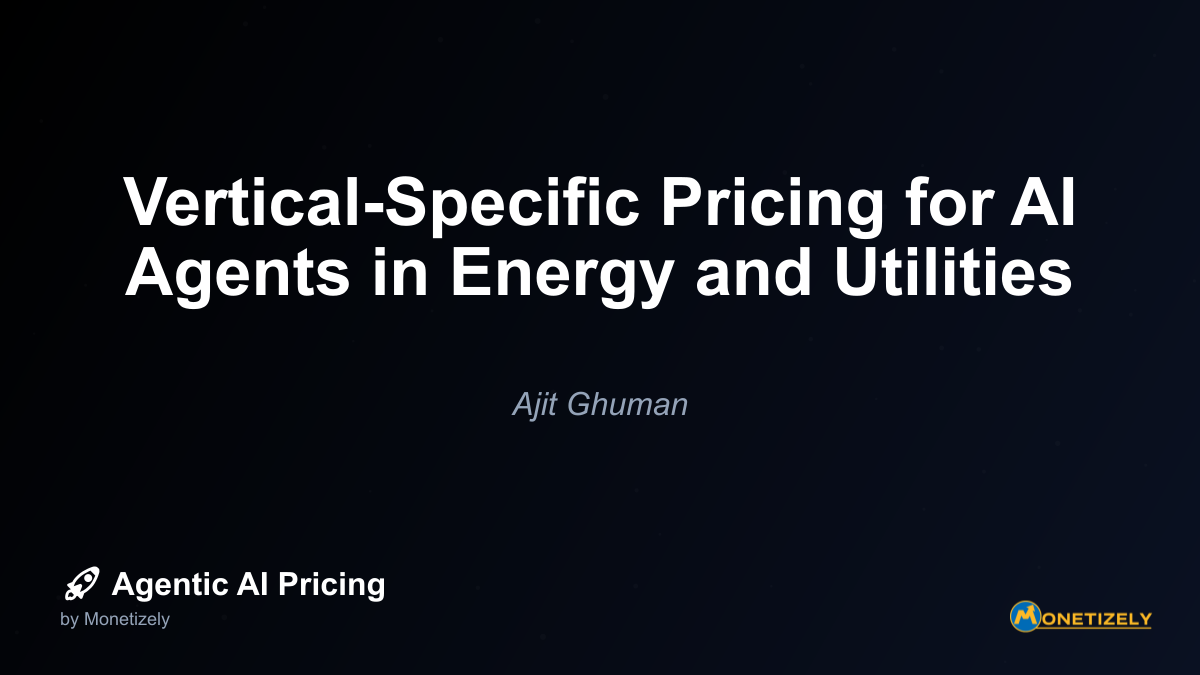
In today’s rapidly evolving energy landscape, utilities face unprecedented challenges in grid management, consumption optimization, and resource allocation. The integration of artificial intelligence agents offers transformative potential for addressing these challenges, but implementing effective pricing strategies for these technologies requires a nuanced understanding of the utility sector’s unique characteristics. This comprehensive analysis explores how AI pricing models are being tailored to the specific needs of energy and utility companies, examining market trends, implementation considerations, and strategic frameworks for maximizing value.
The Evolving Landscape of AI in Energy and Utilities
The energy and utilities sector is undergoing a profound transformation driven by decarbonization mandates, increasing distributed energy resources, and heightened customer expectations. AI technologies are rapidly becoming essential tools for navigating this complex environment, with applications ranging from grid management to consumption optimization and resource allocation.
Current Market Trends (2023-2025)
The adoption of AI in utilities has accelerated significantly in recent years, with 64% of executives expecting moderate increases and 24% anticipating significant increases in AI agent deployment within the next three years. This growth is driven by several key factors:
Rising Energy Demand from AI: U.S. electricity consumption is projected to reach approximately 4,158 billion kWh in 2025, with AI data centers contributing significantly to this demand. Industry forecasts suggest an additional 50 gigawatts of power capacity may be required by 2027 solely to support growing AI workloads.
Grid Utilization Challenges: The current average grid capacity utilization stands at approximately 42%, highlighting significant inefficiency. AI tools are increasingly deployed to improve this metric by smoothing peaks and valleys in energy consumption patterns.
Shift Toward Dynamic Pricing: Utilities are leveraging AI to enable more sophisticated pricing strategies that adjust in real-time based on demand patterns, grid stress, and supply availability. This transition from static to dynamic pricing models represents a fundamental shift in how utilities monetize their services.
Emphasis on Predictive Capabilities: AI-powered predictive maintenance and demand forecasting are becoming standard practice, with utilities seeking solutions that can anticipate failures, optimize resource allocation, and improve customer engagement.
As noted by AI Multiple Research in 2025: “AI is transforming the utilities sector by enhancing efficiency, optimizing energy use, and enabling advanced simulations through technologies like digital twins, but effective adoption depends on addressing challenges such as data quality, legacy integration, and regulatory compliance.”
Dominant Pricing Models for AI in Energy and Utilities
The pricing landscape for AI solutions in the utility sector is diverse, with several models gaining traction based on their alignment with specific use cases and organizational needs.
1. Subscription and SaaS Models
AI grid management and optimization solutions are frequently offered as software-as-a-service (SaaS), with pricing structures that reflect various factors:
Tiered Functionality: Basic tiers typically include real-time monitoring and KPI dashboards, while premium tiers add advanced features like predictive maintenance, load forecasting, and cybersecurity capabilities.
Asset-Based Scaling: Pricing often scales based on the number of endpoints, sensors, or assets being monitored and managed.
Data Volume Considerations: The volume of data processed is a common pricing determinant, reflecting the computational resources required to analyze grid operations.
These subscription models provide utilities with predictable costs while allowing continuous access to evolving AI capabilities and improvements.
2. Dynamic and Usage-Based Pricing
For AI solutions focused on consumption optimization and demand response, usage-based pricing models have gained popularity:
Real-Time Adjustments: AI-powered systems enable utilities to implement dynamic pricing that adjusts to market conditions, with the AI vendor’s compensation sometimes tied to the effectiveness of these adjustments.
Consumption-Linked Fees: Some vendors charge based on the volume of energy managed or optimized, creating alignment between their revenue and the utility’s operations.
Peak Management Incentives: Pricing structures may include bonuses for successfully reducing peak demand or improving load balancing during critical periods.
As highlighted by MaxBill: “AI-driven pricing optimization not only boosts revenues during peak demand but also enhances customer experience through personalized and flexible plans.”
3. Performance-Based and Outcome-Driven Models
Perhaps the most innovative pricing approach in the sector is the performance-based model, which directly ties compensation to measurable outcomes:
Savings Share Arrangements: Companies like Johnson Controls have implemented models where they receive a percentage of the energy savings achieved through their AI solutions. Their systems have delivered average energy savings of 28% with an 11-month payback period.
Efficiency Improvement Bonuses: Pricing structures that include bonuses for meeting or exceeding predefined efficiency targets, such as reducing outage frequency or improving renewable integration.
Risk-Sharing Frameworks: More sophisticated arrangements where vendors share both the upside and downside risk of AI implementation, receiving premium compensation for exceeding targets but penalties for underperformance.
These outcome-driven approaches represent a significant shift from traditional technology procurement models, focusing on value delivery rather than feature sets.
Case Studies: Real-World AI Pricing in Energy and Utilities
Examining specific implementations provides valuable insights into how AI pricing models are being applied in practice.
AES Corporation: AI-Powered Safety and Compliance
AES deployed AI-powered safety audits using Google Cloud’s Vertex AI, achieving remarkable results:
- Cost Reduction: Audit costs decreased by 99%
- Time Efficiency: Tasks that previously required 100 manual hours were completed in just 1 hour
- Improved Accuracy: Significant improvements in regulatory compliance and operational safety
While specific pricing details remain confidential, this implementation demonstrates the substantial value creation potential that justifies premium pricing for AI solutions in the utility sector.
Johnson Controls: Performance-Based Pricing for Commercial Buildings
Johnson Controls implemented an AI-powered savings share pricing model that:
- Aligns Incentives: Compensation is based on actual energy savings achieved rather than fixed fees
- Delivers Rapid ROI: The system paid for itself within 11 months
- Achieves Substantial Savings: Average energy savings of 28% across implementations
This approach exemplifies the shift toward performance-based pricing that creates mutual benefits for both the solution provider and the utility customer.
Renewator: Dynamic Pricing Optimization
Renewator offers AI-based automation focused on energy pricing optimization:
- Real-Time Adjustments: Their machine learning algorithms enable instantaneous price adjustments based on demand fluctuations
- Revenue Enhancement: The solution supports premium pricing during peak demand periods
- Personalization Capabilities: Enables customer-specific pricing and payment plans based on usage patterns and preferences
This case highlights how AI vendors are positioning their solutions as revenue enhancement tools rather than just cost centers, justifying value-based pricing approaches.
Market Segmentation: Enterprise vs. Smaller Utilities
The pricing landscape for AI in utilities varies significantly based on the size and resources of the organization, with clear distinctions between approaches for large enterprise utilities versus smaller municipal or cooperative entities.
Enterprise Utility Pricing Considerations
Large utility companies typically engage with AI vendors through:
- Comprehensive Enterprise Agreements: Long-term contracts with substantial customization and integration services
- Complex Procurement Cycles: 6-18 month sales processes involving multiple stakeholders, security audits, and formal ROI evaluations
- Premium Pricing Justified by Scale: Higher price points reflecting the extensive scope and impact of implementations across large service territories
These organizations have significant IT and AI budgets, often measured in millions of dollars, allowing for sophisticated pricing structures that reflect the complexity of their operations.
Municipal and Cooperative Utility Approaches
Smaller utilities require different pricing approaches that account for their unique constraints:
- Simplified Pricing Tiers: More straightforward packages with clear feature sets and minimal customization
- Faster Adoption Pathways: Pricing models designed for 1-3 month procurement cycles with fewer approval layers
- Modularity and Scalability: Options to start small and expand over time as value is demonstrated and budgets allow
As noted in industry research, these organizations prioritize ease of deployment with minimal IT overhead, making standardized packages and usage-based pricing particularly attractive.
Technical Implementation Costs and ROI Metrics
Understanding the full cost picture and return on investment potential is crucial for utilities evaluating AI solutions.
Implementation Cost Components
The total cost of AI implementation in utilities typically includes:
- Software Licensing: Core AI platform and application fees
- Hardware Infrastructure: IoT sensors, smart meters, and data collection devices
- Integration Services: Connecting AI systems with existing SCADA, ERP, and customer information systems
- Training and Change Management: Preparing staff to effectively utilize AI capabilities
- Ongoing Support and Maintenance: Ensuring continued performance and adaptation
These costs vary significantly based on implementation scope, existing infrastructure, and the selected pricing model.
Key ROI Metrics for AI in Utilities
Utilities evaluate AI investments using several critical metrics:
- Grid Reliability and Uptime: Reduction in downtime frequency and unplanned outages
- Maintenance Cost Reduction: Savings from predictive rather than reactive maintenance
- Load Forecasting Accuracy: Improvements in demand prediction (typically 10-15% enhancement)
- Operational Cost Savings: Overall reductions in operational expenses (often 10-25%)
- Power Quality Improvements: Enhanced delivery consistency and reduced fluctuations
- Response Time to Disturbances: Faster identification and resolution of grid issues
Boston Consulting Group studies suggest AI can improve renewable energy company efficiency by 15-25% and increase energy availability by 2-3 percentage points, providing substantial ROI justification.
Geographic and Market Maturity Variations
The approach to AI pricing in utilities shows significant variation based on geographic location and market maturity.
Developed Markets (North America, Europe, Advanced Asian Economies)
In mature utility markets, AI pricing tends to emphasize:
- Value-Based Approaches: Pricing reflects the higher willingness and ability to pay for comprehensive solutions
- Regulatory Alignment: Pricing structures designed to work within established regulatory frameworks
- Performance Guarantees: Contracts often include specific performance metrics and associated compensation adjustments
- Integration with Existing Digital Infrastructure: Pricing accounts for the complexity of connecting with sophisticated legacy systems
The European Union, in particular, emphasizes transparency and customer protection in AI pricing models, often supported by government incentives to ensure fair cost allocation and alignment with sustainability goals.
Developing Markets
In emerging economies, AI vendors adapt their pricing to address different priorities:
- Cost-Sensitive Structures: More flexible pricing with lower entry points
- Pay-As-You-Go Options: Usage-based models that minimize upfront investment
- Bundled Services: Combining AI with other necessary infrastructure improvements
- Localized Support: Pricing that includes market-specific implementation assistance
These adaptations reflect the different infrastructure challenges, regulatory environments, and investment capabilities in developing utility markets.
Pricing Variations by AI Application Type
The pricing approach for AI in utilities also varies significantly based on the specific application area, with each use case commanding different pricing structures based on its value proposition and implementation complexity.
Grid Management AI Pricing
AI solutions for grid management and optimization typically feature:
- Outcome-Based Models: Pricing tied to efficiency gains and load optimization
- Continuous Monitoring Requirements: Pricing structures that reflect the need for ongoing data collection and analysis
- Scalability Considerations: Costs that increase with the size and complexity of the grid being managed
These solutions often represent the highest-value AI applications for utilities, with pricing that reflects their direct impact on core operations.
Customer Engagement AI Pricing
For AI applications focused on customer interaction and consumption optimization:
- Dynamic, Personalized Pricing Plans: Flexible options that adapt to customer behavior
- Prepaid or Flexible Payment Options: Models that improve cash flow and reduce collection risks
- Subscription-Based Customer Services: Recurring revenue models for ongoing customer engagement
These applications typically command lower price points than grid management solutions but offer valuable customer retention and satisfaction benefits.
Supply Chain and Asset Management AI Pricing
AI tools for optimizing utility supply chains and asset management often use:
- Cost Savings Percentage Models: Pricing based on demonstrated reductions in procurement or maintenance costs
- Asset Lifecycle Extension Metrics: Value tied to extending the useful life of expensive infrastructure
- Inventory Optimization Incentives: Compensation linked to reductions in carrying costs or stockouts
Leading energy companies have reported cost reductions of 10-25% and productivity gains of 3-8% in supply chain management after AI adoption, providing clear ROI metrics for these pricing models.
Regulatory Considerations Affecting AI Pricing
The heavily regulated nature of the utility industry creates unique challenges and opportunities for AI pricing strategies.
Rate Recovery Mechanisms
Utilities must consider how AI investments will be treated by regulators:
- Capital vs. Operating Expenditure Classification: Different regulatory treatment depending on how AI costs are categorized
- Rate Case Implications: How AI investments will be presented in rate increase requests
- Performance-Based Ratemaking Alignment: Ensuring AI pricing aligns with regulatory incentives for utility performance
These considerations often favor subscription or service-based pricing models that can be more easily integrated into operating expenses rather than large capital investments.
Data Privacy and Security Requirements
Regulatory mandates around customer data and critical infrastructure protection influence AI pricing:
- Compliance Premium: Higher pricing for solutions with robust security and privacy features
- Certification Costs: Pricing that reflects the expense of maintaining regulatory certifications
- Liability Allocation: How pricing structures address potential regulatory penalties for data breaches or security incidents
As utilities collect and analyze increasingly granular consumption data, these regulatory factors become more significant in AI pricing decisions.
Emerging AI-Specific Regulations
New regulatory frameworks specifically addressing AI are beginning to emerge:
- Algorithmic Transparency Requirements: Potential pricing premiums for explainable AI solutions
- Fairness and Bias Prevention: Additional costs for ensuring AI systems meet equity standards
- Regulatory Reporting Features: Pricing that includes automated compliance documentation
These emerging requirements may create pricing differentiation opportunities for vendors who proactively address regulatory concerns.
Future Trends in AI Pricing for Utilities (2025-2027)
Looking ahead, several key trends are likely to shape the evolution of AI pricing in the utility sector.
Increased Autonomy and Self-Optimization
As AI agents become more autonomous in their decision-making capabilities:
- Pricing Based on Autonomy Level: Tiered pricing reflecting the degree of human oversight required
- Self-Optimization Incentives: Compensation structures that reward AI systems for continuous improvement
- Complexity-Based Pricing: Models that reflect the sophistication of decisions being automated
This trend aligns with the broader movement toward more intelligent, self-managing utility systems that require less human intervention.
Integration with Renewable and Distributed Energy Resources
The growing importance of renewable energy and distributed resources will influence AI pricing:
- Virtual Power Plant Models: Pricing structures for AI that aggregates and optimizes distributed resources
- Renewable Forecasting Premium: Higher value placed on accurate prediction of variable generation
- Flexibility Service Compensation: Pricing tied to the AI’s ability to manage grid flexibility and stability
These applications represent some of the highest-value use cases for AI in utilities, likely commanding premium pricing based on their contribution to decarbonization goals.
Hyper-Personalization of Customer Experience
AI-driven personalization of utility services will create new pricing opportunities:
- Customer Segment-Specific Pricing: Different AI service tiers based on customer value and needs
- Behavioral Analytics Premium: Higher pricing for advanced customer insight capabilities
- Engagement-Based Models: Pricing tied to improvements in customer satisfaction or participation rates
As utilities compete more actively for customer loyalty, these personalization capabilities will become increasingly valuable and priced accordingly.
Blockchain and Smart Contract Integration
The combination of AI with blockchain technology will enable new pricing approaches:
- Automated Settlement Models: Pricing structures that leverage smart contracts for immediate settlement
- Microtransaction Capabilities: Finer-grained pricing based on very specific AI actions or decisions
- Transparent Value Attribution: Clearer tracking of AI contribution to outcomes and appropriate compensation
These innovations promise to reduce friction in performance-based pricing models while improving transparency for all stakeholders.
Strategic Framework for AI Pricing in Utilities
Based on the comprehensive analysis of current practices and emerging trends, a strategic framework for AI pricing in the utility sector emerges.
Value-Based Foundation
The most effective AI pricing strategies in utilities start with a clear understanding of value creation:
- Identify Value Levers: Determine exactly how and where AI creates measurable value (e.g., reduced outages, lower peak demand, improved customer retention)
- Quantify Value Potential: Establish realistic estimates for the financial impact of these improvements
- Align Pricing Structure: Design pricing that proportionally captures a share of this created value
- Implement Verification Mechanisms: Establish clear methods for measuring actual value delivery
As noted in industry research: “Savings share pricing aligns incentives between providers and clients by sharing financial benefits, enabled by accurate AI verification and autonomous optimization.”
Stakeholder-Centric Design
Successful AI pricing in utilities must address the needs of multiple stakeholders:
- Executive Leadership: Demonstrable ROI and strategic alignment
- Operations Teams: Usability and integration with existing workflows
- Regulatory Affairs: Compliance and rate case supportability
- Customers: Improved service quality and reasonable rate impacts
Pricing structures that acknowledge and balance these sometimes competing priorities tend to achieve greater acceptance and implementation success.
Flexibility and Adaptability
Given the rapidly evolving nature of both AI technology and utility business models, pricing approaches must incorporate flexibility:
- Scalability Provisions: Clear pathways for expanding scope or functionality over time
- Performance Adjustment Mechanisms: Methods for revising pricing based on actual outcomes
- Technology Refresh Considerations: How pricing accommodates updates and improvements to AI capabilities
This flexibility is particularly important given the long asset lifecycles and planning horizons typical in the utility industry.
Implementation Challenges
Co-Founder & CEO
Ajit is the author of Price To Scale, a top book on SaaS Pricing and is the Founder of Monetizely. Ajit has led and worked in pricing and product marketing at firms like Twilio, Narvar and Medallia. His work has been featured in Forbes and VentureBeat. Ajit regularly consults with software companies from Seed stage to post-IPO on pricing strategy. Ajit is also a highly-rated co-instructor for 'The Art of SaaS Pricing and Monetization' on Maven.
Pricing Strategy Audit
Let our experts analyze your current pricing strategy and identify opportunities for improvement. Our data-driven assessment will help you unlock untapped revenue potential and optimize your AI pricing approach.

